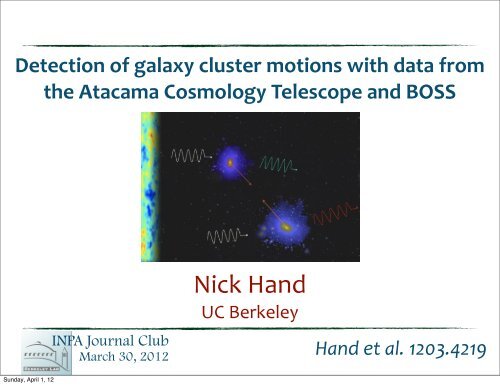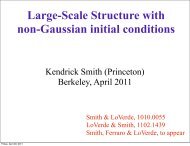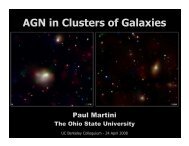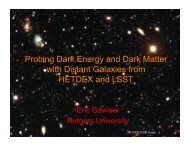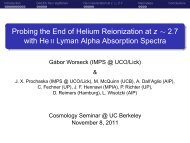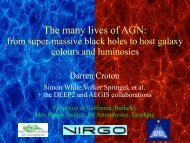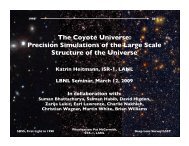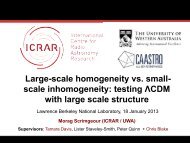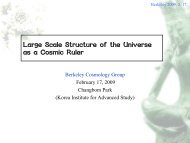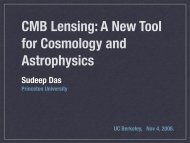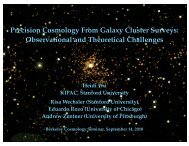Nick Hand - Berkeley Cosmology Group
Nick Hand - Berkeley Cosmology Group
Nick Hand - Berkeley Cosmology Group
Create successful ePaper yourself
Turn your PDF publications into a flip-book with our unique Google optimized e-Paper software.
Detection of galaxy cluster motions with data from<br />
Sunday, April 1, 12<br />
the Atacama <strong>Cosmology</strong> Telescope and BOSS<br />
INPA Journal Club<br />
<strong>Nick</strong> <strong>Hand</strong><br />
UC <strong>Berkeley</strong><br />
<strong>Hand</strong> et al. 1203.4219<br />
March 30, 2012 <strong>Nick</strong> <strong>Hand</strong>, UC <strong>Berkeley</strong> 1
Sunday, April 1, 12<br />
Outline<br />
•SZ background information<br />
•order of magnitude estimates<br />
•breakdown of <strong>Hand</strong> et al. 1203.4219<br />
-‐ methodology<br />
-‐ results<br />
•applications / future work<br />
INPA Journal Club<br />
March 30, 2012 <strong>Nick</strong> <strong>Hand</strong>, UC <strong>Berkeley</strong> 2
Sunday, April 1, 12<br />
Some historical context ...<br />
Sunyaev & Zel’dovich (1972)<br />
How to explain the<br />
observed ‘hole’ in<br />
the Coma cluster?<br />
INPA Journal Club<br />
March 30, 2012 <strong>Nick</strong> <strong>Hand</strong>, UC <strong>Berkeley</strong> 3
Sunday, April 1, 12<br />
The thermal Sunyaev-‐Zel’dovich effect<br />
Menanteau et al. (2012)<br />
TtSZ<br />
TCMB<br />
= f(x)y =<br />
-‐ inverse Compton scattering between<br />
free electrons and CMB photons<br />
-‐ arcminute-‐scale decrement at 148 GHz<br />
-‐ measures the thermal content<br />
-‐ nearly independent of redshift<br />
✓ x(e x + 1)<br />
e x 1<br />
◆ Z<br />
4<br />
unique frequency<br />
dependence<br />
electron gas<br />
pressure<br />
INPA Journal Club<br />
March 30, 2012 <strong>Nick</strong> <strong>Hand</strong>, UC <strong>Berkeley</strong> 4<br />
T<br />
nekTe<br />
d`<br />
mec2
Sunday, April 1, 12<br />
The thermal Sunyaev-‐Zel’dovich effect<br />
Menanteau et al. (2012)<br />
TtSZ<br />
TCMB<br />
= f(x)y =<br />
-‐ inverse Compton scattering between<br />
free electrons and CMB photons<br />
-‐ arcminute-‐scale decrement at 148 GHz<br />
-‐ measures the thermal content<br />
-‐ nearly independent of redshift<br />
✓ x(e x + 1)<br />
e x 1<br />
◆ Z<br />
4<br />
unique frequency<br />
dependence<br />
electron gas<br />
pressure<br />
INPA Journal Club<br />
March 30, 2012 <strong>Nick</strong> <strong>Hand</strong>, UC <strong>Berkeley</strong> 4<br />
T<br />
nekTe<br />
d`<br />
mec2
Sunday, April 1, 12<br />
The kinematic Sunyaev-‐Zel’dovich effect<br />
TkSZ<br />
TCMB<br />
= ⌧<br />
-‐ Doppler-‐induced temperature distortion<br />
of CMB photons<br />
-‐ measures integrated momentum<br />
-‐ no frequency dependence for<br />
temperature distortion<br />
-‐ also nearly independent of redshift<br />
⇣ vpec<br />
c<br />
⌘<br />
=<br />
electron gas<br />
momentum<br />
INPA Journal Club<br />
March 30, 2012 <strong>Nick</strong> <strong>Hand</strong>, UC <strong>Berkeley</strong> 5<br />
Z<br />
T<br />
nevpec<br />
c<br />
d`
Sunday, April 1, 12<br />
The SZ shifts for a massive cluster<br />
assumes kTe = 5 keV, vpec = 300 km/s<br />
kSZ signal is<br />
smaller by an<br />
order of<br />
magnitude!<br />
INPA Journal Club<br />
March 30, 2012 <strong>Nick</strong> <strong>Hand</strong>, UC <strong>Berkeley</strong> 6
Measuring the kSZ effect with ACT<br />
• PI: Lyman Page, Princeton<br />
• 80 scientists on 5 continents<br />
• 6-‐meter telescope on Cerro<br />
Tocco (5200 m) in the<br />
Atacama Desert.<br />
• Observing the sky at 148, 218<br />
and 277 GHz<br />
Sunday, April 1, 12<br />
INPA Journal Club<br />
March 30, 2012 <strong>Nick</strong> <strong>Hand</strong>, UC <strong>Berkeley</strong> 7
Measuring the kSZ effect with ACT<br />
• PI: Lyman Page, Princeton<br />
• 80 scientists on 5 continents<br />
• 6-‐meter telescope on Cerro<br />
Tocco (5200 m) in the<br />
Atacama Desert.<br />
• Observing the sky at 148, 218<br />
and 277 GHz<br />
Sunday, April 1, 12<br />
How to achieve necessary S/N for a kSZ<br />
measurement?<br />
INPA Journal Club<br />
March 30, 2012 <strong>Nick</strong> <strong>Hand</strong>, UC <strong>Berkeley</strong> 7
Sunday, April 1, 12<br />
Cross-‐correlate ACT with BOSS!<br />
INPA Journal Club<br />
March 30, 2012 <strong>Nick</strong> <strong>Hand</strong>, UC <strong>Berkeley</strong> 8
BOSS in process of obtaining spectra for 1.5<br />
million luminous galaxies<br />
Two galaxy samples in upcoming DR9 release<br />
LOZ: 0.2 < z < 0.4, zmed ~ 0.3<br />
CMASS: 0.4 < z < 0.7, zmed ~ 0.57<br />
Preferentially sit in massive halos: ~10 13 -‐ 10 14 Msun<br />
Sunday, April 1, 12<br />
Mapping ‘Luminous Galaxies’ with BOSS<br />
INPA Journal Club<br />
March 30, 2012<br />
<strong>Nick</strong> <strong>Hand</strong>, UC <strong>Berkeley</strong><br />
9
BOSS in process of obtaining spectra for 1.5<br />
million luminous galaxies<br />
Two galaxy samples in upcoming DR9 release<br />
LOZ: 0.2 < z < 0.4, zmed ~ 0.3<br />
CMASS: 0.4 < z < 0.7, zmed ~ 0.57<br />
Preferentially sit in massive halos: ~10 13 -‐ 10 14 Msun<br />
Sunday, April 1, 12<br />
Mapping ‘Luminous Galaxies’ with BOSS<br />
Redshifts/sky locations<br />
for thousands of<br />
potential clusters<br />
INPA Journal Club<br />
March 30, 2012<br />
<strong>Nick</strong> <strong>Hand</strong>, UC <strong>Berkeley</strong><br />
9
BOSS in process of obtaining spectra for 1.5<br />
million luminous galaxies<br />
Two galaxy samples in upcoming DR9 release<br />
LOZ: 0.2 < z < 0.4, zmed ~ 0.3<br />
CMASS: 0.4 < z < 0.7, zmed ~ 0.57<br />
Preferentially sit in massive halos: ~10 13 -‐ 10 14 Msun<br />
Sunday, April 1, 12<br />
Mapping ‘Luminous Galaxies’ with BOSS<br />
Redshifts/sky locations<br />
for thousands of<br />
potential clusters<br />
INPA Journal Club<br />
March 30, 2012<br />
Two relevant questions:<br />
<strong>Nick</strong> <strong>Hand</strong>, UC <strong>Berkeley</strong><br />
9
Mapping ‘Luminous Galaxies’ with BOSS<br />
BOSS in process of obtaining spectra for 1.5<br />
million luminous galaxies<br />
Two galaxy samples in upcoming DR9 release<br />
LOZ: 0.2 < z < 0.4, zmed ~ 0.3<br />
CMASS: 0.4 < z < 0.7, zmed ~ 0.57<br />
Redshifts/sky locations<br />
for thousands of<br />
Preferentially sit in massive halos: ~10 13 -‐ 10 14 Msun<br />
potential clusters<br />
INPA Journal Club<br />
March 30, 2012<br />
Two relevant questions:<br />
1. What tSZ/kSZ amplitude should we expect in<br />
this halo mass range?<br />
Sunday, April 1, 12<br />
<strong>Nick</strong> <strong>Hand</strong>, UC <strong>Berkeley</strong><br />
9
Mapping ‘Luminous Galaxies’ with BOSS<br />
BOSS in process of obtaining spectra for 1.5<br />
million luminous galaxies<br />
Two galaxy samples in upcoming DR9 release<br />
LOZ: 0.2 < z < 0.4, zmed ~ 0.3<br />
CMASS: 0.4 < z < 0.7, zmed ~ 0.57<br />
Redshifts/sky locations<br />
for thousands of<br />
Preferentially sit in massive halos: ~10 13 -‐ 10 14 Msun<br />
potential clusters<br />
INPA Journal Club<br />
March 30, 2012<br />
Two relevant questions:<br />
1. What tSZ/kSZ amplitude should we expect in<br />
this halo mass range?<br />
2. How many galaxies to achieve a given S/N?<br />
Sunday, April 1, 12<br />
<strong>Nick</strong> <strong>Hand</strong>, UC <strong>Berkeley</strong><br />
9
SZ vs halo mass: order of magnitude scaling<br />
Thermal SZ Kinematic SZ<br />
TtSZ / ⌧(M)Te(M)<br />
Te / M 2/3<br />
⌧ / M<br />
TtSZ / M 5/3<br />
If |δTtSZ| = 10 |δTkSZ| at M = 10 15 Msun:<br />
Sunday, April 1, 12<br />
TkSZ / ⌧(M)<br />
⌧ / M<br />
TkSZ / M<br />
SZ signals equal at Meq ≃ 3 x 10 13 Msun<br />
INPA Journal Club<br />
March 30, 2012 <strong>Nick</strong> <strong>Hand</strong>, UC <strong>Berkeley</strong> 10
δTtSZ at 148 GHz<br />
δTkSZ uses<br />
vpec = 300 km/s<br />
|δTtSZ| ~ |δTkSZ|<br />
~ 1 μK<br />
in relevant halo<br />
mass range for BOSS<br />
Sunday, April 1, 12<br />
a little more quantitatively ...<br />
Meq ≃ 2.1 x 10 13 Msun<br />
INPA Journal Club<br />
March 30, 2012 <strong>Nick</strong> <strong>Hand</strong>, UC <strong>Berkeley</strong> 11
How many galaxies for a given kSZ S/N?<br />
• Consider Poisson noise in Nobj: Npoisson / (Nobj) 1/2<br />
• Estimate the ACT pixel noise:<br />
Sunday, April 1, 12<br />
order of magnitude estimate:<br />
Nobj ⇠<br />
apple (S/N) ACT<br />
TkSZ(M)<br />
INPA Journal Club<br />
March 30, 2012 <strong>Nick</strong> <strong>Hand</strong>, UC <strong>Berkeley</strong> 12<br />
2<br />
ACT ' 20 µK/pixel
Sunday, April 1, 12<br />
How many galaxies for a given kSZ S/N?<br />
5,000 -‐ 10,000<br />
galaxies needed for<br />
~4σ detection at<br />
average mass<br />
~4 x 10 13 Msun<br />
INPA Journal Club<br />
March 30, 2012 <strong>Nick</strong> <strong>Hand</strong>, UC <strong>Berkeley</strong> 13
Sunday, April 1, 12<br />
How many galaxies for a given kSZ S/N?<br />
5,000 -‐ 10,000<br />
galaxies needed for<br />
~4σ detection at<br />
average mass<br />
~4 x 10 13 Msun<br />
possible with<br />
ACT x BOSS<br />
correlation<br />
INPA Journal Club<br />
March 30, 2012 <strong>Nick</strong> <strong>Hand</strong>, UC <strong>Berkeley</strong> 13
ACT Data<br />
•148 GHz sky map taken from<br />
2008-2010<br />
• strip 3° wide and 110° long<br />
centered on celestial equator<br />
• 1.4′ angular resolution<br />
• noise per pixel: 15 - 25 μK<br />
Sunday, April 1, 12<br />
BOSS Data<br />
• galaxies drawn from both<br />
CMASS and LOZ DR9 samples<br />
• right ascension slightly smaller<br />
than ACT footprint:<br />
−43° < α < 45°<br />
-‐ 27,291 BOSS galaxies in overlap region<br />
-‐ about 100 galaxies per sq. degree on sky<br />
-‐ exclude any galaxies falling within 1′ of 1.4 GHz<br />
FIRST radio source<br />
INPA Journal Club<br />
March 30, 2012 <strong>Nick</strong> <strong>Hand</strong>, UC <strong>Berkeley</strong> 14
Sunday, April 1, 12<br />
Sample redshift distribution<br />
range: 0.05 < z < 0.8<br />
mean redshift: z = 0.51<br />
INPA Journal Club<br />
March 30, 2012 <strong>Nick</strong> <strong>Hand</strong>, UC <strong>Berkeley</strong> 15
Verifying the galaxy sample traces massive halos ...<br />
First, stack filtered ACT data at galaxy locations to<br />
compute tSZ signal<br />
Sunday, April 1, 12<br />
-‐ Filtering process identical to <strong>Hand</strong> et al., ApJ (2011)<br />
-‐ Before applying the filter:<br />
-‐ Mask point sources with S/N > 5 in ACT data<br />
-‐ weight map by q<br />
Nobs(x)/Nobs,max<br />
INPA Journal Club<br />
March 30, 2012 <strong>Nick</strong> <strong>Hand</strong>, UC <strong>Berkeley</strong> 16
Verifying the galaxy sample traces massive halos ...<br />
-‐ match filter ACT data in Fourier space:<br />
Tfilt(k) =<br />
signal profile B(θ) chosen<br />
to be equal to ACT 148 GHz<br />
beam function (θ = 1.4′)<br />
Sunday, April 1, 12<br />
˜B ? (k) | ˜ T other(k)| 2 ˜ T (k)<br />
R ˜B ? (k 0 ) | ˜ T other(k 0 )| 2 ˜ B(k 0 )dk 0<br />
INPA Journal Club<br />
March 30, 2012 <strong>Nick</strong> <strong>Hand</strong>, UC <strong>Berkeley</strong> 17
Sunday, April 1, 12<br />
tSZ Stacking Methods<br />
-‐ Verify that galaxy luminosity correlates with halo mass<br />
-‐ Bin galaxy sample by r-‐band luminosity, as in <strong>Hand</strong> et<br />
al., ApJ (2011)<br />
-‐ luminosities computed from CMODEL magnitudes<br />
-‐ Perform weighted sum of filtered ACT 10′ x 10′ submaps<br />
centered on each galaxy<br />
INPA Journal Club<br />
March 30, 2012 <strong>Nick</strong> <strong>Hand</strong>, UC <strong>Berkeley</strong> 18
148 GHz<br />
Sunday, April 1, 12<br />
results<br />
tSZ Stacking Results<br />
218 GHz results<br />
‘dust-‐subtracted’<br />
148 GHz results<br />
TtSZ ⌘ T148 0.325 T218<br />
see Hall et al., 2010<br />
(SPT power spectra)<br />
INPA Journal Club<br />
March 30, 2012 <strong>Nick</strong> <strong>Hand</strong>, UC <strong>Berkeley</strong> 19
Sunday, April 1, 12<br />
now on to measuring the kSZ signal ...<br />
INPA Journal Club<br />
March 30, 2012 <strong>Nick</strong> <strong>Hand</strong>, UC <strong>Berkeley</strong> 20
The pairwise momentum statistic<br />
now have thousands of cluster line-‐of-‐sight momenta, from<br />
kSZ temperature shift in ACT data<br />
-‐ compute the mean pairwise momentum:<br />
ppair(r) ⌘h(p i<br />
p j) · ˆriji<br />
-‐ ppair < 0 when two objects moving towards each other<br />
-‐ measures the mean tendency of objects to approach<br />
each other due to gravitational attraction<br />
Sunday, April 1, 12<br />
INPA Journal Club<br />
March 30, 2012 <strong>Nick</strong> <strong>Hand</strong>, UC <strong>Berkeley</strong> 21
The pairwise momentum statistic<br />
-‐ we can estimate ppair using only line-‐of-‐sight momenta:<br />
˜ppair(r) =<br />
P<br />
i
Pairwise Momentum from the kSZ Shift<br />
-‐ relate line-‐of-‐sight momenta to measured kSZ<br />
temperature shift in ACT data<br />
TkSZ,i ⌘ NkSZ p i · ˆri<br />
-‐ NkSZ depends on ACT pixel scale, beam size, cluster profile<br />
estimate NkSZ from Seghal et al.<br />
(2010) microwave sky simulations<br />
Sunday, April 1, 12<br />
vpec = 200 km/s, M200 = 10 13 Msun:<br />
|TkSZ| ≃ 0.9 μK<br />
vpec = 200 km/s, M200 = 10 14 Msun:<br />
|TkSZ| ≃ 2.2 μK<br />
INPA Journal Club<br />
March 30, 2012 <strong>Nick</strong> <strong>Hand</strong>, UC <strong>Berkeley</strong> 23
Possible Contamination Sources<br />
-‐ advantageous systematic error properties<br />
-‐ linear and differential<br />
-‐ tSZ signal from individuals clusters will subtract out<br />
-‐ redshift-‐dependent signals can lead to erroneous signal<br />
Sunday, April 1, 12<br />
-‐ subtract out mean temperature at given redshift<br />
˜pkSZ(r) =<br />
P<br />
i
Sunday, April 1, 12<br />
Mean Pairwise Momentum Detection<br />
-‐ bin errors computed by bootstrap resampling<br />
-‐ 3.8σ away from zero, including correlations<br />
between bins<br />
compute pkSZ for<br />
7500 most<br />
luminous galaxies<br />
using ACT 148<br />
data, filtered at<br />
scale θ = 4.2′<br />
INPA Journal Club<br />
March 30, 2012 <strong>Nick</strong> <strong>Hand</strong>, UC <strong>Berkeley</strong> 25
compute same<br />
summation for pkSZ but:<br />
Sunday, April 1, 12<br />
1. using random sky<br />
locations (blue)<br />
2. changing the sign in<br />
the 2nd term of pkSZ<br />
from negative to<br />
positive (red)<br />
Null Tests<br />
both tests consistent with zero<br />
INPA Journal Club<br />
March 30, 2012 <strong>Nick</strong> <strong>Hand</strong>, UC <strong>Berkeley</strong> 26
Sunday, April 1, 12<br />
Fitting for the average halo mass<br />
-‐ we can relate the kSZ momentum estimator to<br />
the mean pairwise velocity:<br />
pkSZ(r) =NkSZ hMhaloi fb vpair(r) baryon<br />
fraction<br />
-‐ assume fb equal to cosmological value<br />
-‐ vary in Seghal et al. simulations to get best fit to<br />
data results:<br />
hM200i '4.0 ⇥ 10 13 M<br />
M200,cut ' 2.5 ⇥ 10 13 M<br />
roughly consistent with BOSS clustering masses<br />
INPA Journal Club<br />
March 30, 2012 <strong>Nick</strong> <strong>Hand</strong>, UC <strong>Berkeley</strong> 27
Missing Baryon Problem<br />
-‐ baryon fraction known at high redshift from Big Bang<br />
nucleosynthesis and at z ≃ 3 from studies of Lyα lines<br />
-‐ census of baryons at low redshift<br />
Sunday, April 1, 12<br />
➡ only 1/10 of amount at high redshift<br />
‘missing’ baryons believed to be gas filaments connecting<br />
virialized groups and clusters (~0.5 -‐ 10 x 10 6 K)<br />
INPA Journal Club<br />
March 30, 2012 <strong>Nick</strong> <strong>Hand</strong>, UC <strong>Berkeley</strong> 28
Using pkSZ to measure the baryon fraction?<br />
-‐ kSZ effect is proportional to electron gas number density<br />
-‐ no dependence on temperature (unlike tSZ effect)<br />
ACT maps filtered at scale 4.2′, corresponds to ~1 Mpc at z= 0.5<br />
pkSZ is measuring fb on Mpc scales in groups/clusters<br />
Need to carefully compute and for galaxy sample:<br />
Sunday, April 1, 12<br />
pkSZ(r) =NkSZ hMhaloi fb vpair(r)<br />
compute vpair(r) using , assuming fiducial ΛCDM model<br />
measure fb from the amplitude of pkSZ<br />
INPA Journal Club<br />
March 30, 2012 <strong>Nick</strong> <strong>Hand</strong>, UC <strong>Berkeley</strong> 29
Sunday, April 1, 12<br />
Summary<br />
-‐ kSZ effect sensitive to cluster motions on cosmological<br />
scales unique probe of large scale structure<br />
-‐ combination of ACT and BOSS data sets has detected<br />
galaxy cluster motions using the kSZ effect<br />
-‐ kSZ effect probes electron distribution around groups /<br />
clusters finding the missing baryons?<br />
-‐ future improved measurements:<br />
ACTPol: increased sensitivity, larger sky coverage<br />
BigBOSS: deeper with increased sky coverage<br />
-‐ kSZ effect opening new window into the large scale<br />
structure<br />
INPA Journal Club<br />
March 30, 2012 <strong>Nick</strong> <strong>Hand</strong>, UC <strong>Berkeley</strong> 30
Sunday, April 1, 12<br />
Thank You<br />
INPA Journal Club<br />
March 30, 2012 <strong>Nick</strong> <strong>Hand</strong>, UC <strong>Berkeley</strong> 31


